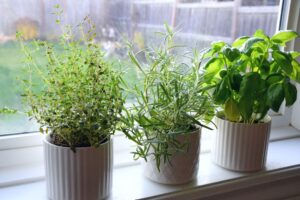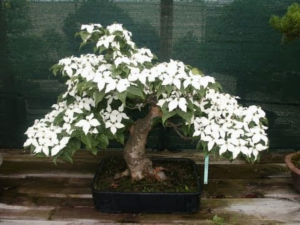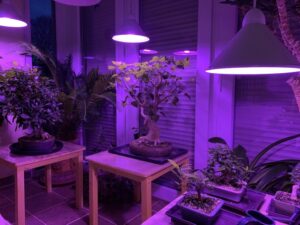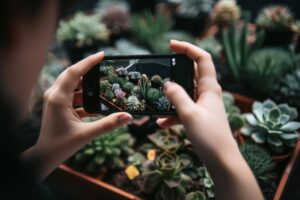An apple tree can truly be bonsaied.
There’s nothing else like an Apple tree Bonsai—it’s a complete apple tree, complete with fruit, but compressed into a tiny package.
You’re in the right place if you want to know how to bonsai an apple tree.
For your convenience, we’ve compiled all the information on how to grow and care for apple bonsai trees.
Bonsai plants for beginners: If you’re new to bonsai plants, it’s important to start with plants that are easy to care for. Some bonsai plants for beginners include juniper, pine, and maple trees. You should also choose plants that are appropriate for the climate in your area.
Apple Bonsai Tree Key Facts
| Botanical Name | Clusia Rosea |
| Description | The tree belongs to the American tropics. It has a dense form with deep green leaves. In summer the tree bears pendent pink and white flowers. This later forms the green fruit. The aerial root of the tree is bonsai friendly. |
| Position | Sunny location, the apple bonsai can be grown in full or semi-shade in USDA zone 11 and 12. |
| Watering | Regular watering is needed. Increase watering when the tree begins to bear fruit. |
| Fertilizer | Twice a month with a balanced fertilizer. Do not feed when it is fruiting. |
| Leaf and branch pruning | Spring is the Suitable time for pruning. Remove new leaves and bud for proper aeration. |
| Repotting and Growing medium | When grown in a container, repotting is needed after every 3-4 years. Or when roots get pot bounded, watering becomes difficult. Repotting should be done in early or mid-spring. |
| Wiring | Should be done in spring before the emergence of new leaves and buds. |
| Notes | The pitch apple bonsai tree is commonly known as the autograph tree. Generally, a leaf will retain the trace of a word or name carved into its surface. |
Growing Apple Bonsai Trees
Many bonsai gardeners go the extra mile by growing their trees instead of purchasing them.
Apple seeds or apple cuttings can be used to grow apple bonsai trees. As apple trees are not self-pollinating, you need at least two apple plants of a different variety for your bonsai to bear fruits.
Take a look at both methods to get an apple tree to grow into a perfect bonsai.
The following thing you will need,
- Apple Bonsai seed
- Aluminum wires or annealed copper wire
- Bonsai Pot
- Aggregates (Akadama, decomposed granite, diatomite, pumic, sand with coarse grains and surface.)
- Balanced Fertilizer
- Growing soil for bonsai
- Sharp Scissors
- Pliers
Growing Apple Bonsai Tree through Cuttings
- To grow apple bonsai through cutting, choose the healthy apple tree.
- As mentioned above, the apple tree should be of different types.
- While harvesting your cuttings, use a sterile cutter. Also, a diagonal cut is preferred while harvesting cuttings.
- Now, you should immediately place your cuttings in water after harvesting. Because air should be prevented from getting inside the cutting of the stem.
- Have patience and allow the cuttings to develop roots. You can use the grafting technique to produce good roots.
- When healthy and thick roots are developed, transfer the cuttings into the pot.
- You should water the cuttings daily to keep the soil moist.
Growing Apple Bonsai from Seeds
- Collect the seeds of a different apple tree. Dry the seeds outside the shell using a dry paper towel.
- Cover the seed with a damp paper towel and place them in a sealable plastic bag.
- Apple seed grows roots and sprouts in winter. Hence you need to take care in that growing season.
- Keep your sealed seeds in the refrigerator between forty and fifty degrees Fahrenheit for about 75 days. To align seed growth with the seed’s best season, this is best done in winter.
- After the required time is elapsed, remove the seeds from the refrigerator for planting.
- Use some neutral ph soil with no fertilizer while planting.
- Water the seed immediately to allow the soil to settle quickly around the seeds.
- Place the pot near the window or environment with matching or above room temperature.
- As the seedling grows over weeks, water them daily.
Caring for Apple Bonsai After Planting
If you desire to grow your apple bonsai properly and produce edible little apples, you need to have a great deal of patience. To care for apple bonsai you need to understand its basic needs. The tree is loveliest when it blooms and more interesting when it bears fruit. Study the following requirement and care to make your tree grow healthy.
Growing Position
- Bonsai apple prefers a sunny location.
- Place the tree near the window or balcony to get direct sunlight.
- While growing trees in winter, the roots should be mulched (a layer of material applied to the surface of the soil) to protect the tree from extreme temperature.
Soil:
A suitable soil mix contains useful microorganisms and tons of organic matter that is important to the health of the tree. It also lets air contact the roots and has enough water retention capacity that the tree can thrive, but not so much that the roots are suffocated.
Watering
- Apple bonsai needs regular watering to keep the soil moist.
- Increase the frequency of watering when the tree starts to bear fruit.
- The soil should never be waterlogged.
- Water only when the soil is dry.
Feeding
- An apple bonsai requires balanced fertilizer.
- Feeding should be done at least twice a month.
- Not to use fertilizer when a tree is bearing fruits.
- Do follow the fertilizer manufacturer’s instructions on how to feed a tree.
Leaf and Branch Pruning
- Remove leaves as needed to allow air to circulate in and around trees.
- Adequate air circulation improves the overall shape of the tree.
- An apple bonsai leaves can grow thick so pruning is required accordingly.
- The best time to prune the tree is in spring. Because this is the time before leaves emerge.
- Prune the tree using sterile or clean pruning shears to avoid the transfer of mold or disease.
Fertilize
- In the growing phase, fertilize the apple pre-bonsai tree with a nitrogenous fertilizer.
- The commercially available liquid bonsai fertilizer is well suited.
- Japanese pellet fertilizers like Biogold and Hanagokoro are also very effective.
- Adding a few pellets every 4-6 weeks will guarantee the balanced fertilization of an apple bonsai tree.
Wiring an Apple Bonsai Tree
- If you are wiring your apple bonsai for the first time, use anodized aluminum wire.
- Shape your tree in spring before new leaves and buds start to develop.
- While applying wire the tree limbs should be dry.
- The branches of apple bonsai are soft. After removing the wire the tree tends to return to its original position. Therefore a wire should stay on the tree as long as possible.
- For this reason, it is advisable to wire a bonsai tree in summer.
- If the wire does not push in the branch it can stay on the tree at least until summer.
The most common material used to prevent tree injury is Raffia. It is made from palm fiber, you can get this from garden stores. Raffia is soaked in water and wrapped around the tips of branches or bark. This will protect branches from damage due to wiring.
How to Prevent Pests and Diseases
- Once the tree starts to grow you need to protect it from possible diseases or pests like webworm mites, aphids, tent caterpillar, blight, or a scab infection.
- You can either take off the bugs from your hand or can use insecticides.
- An insecticide can be sprayed next to the roots, and the tree will take it in through its roots, or you can Spray the tree so that the insects or pests eat the poison.
- In order to avoid endangering other animals or plants, you can use green or natural bug killers.
- The major insects and pests that affect the bonsai apple trees are maggot flies, plum curculio, and codling moths.
Apple Maggot
- Apple maggot flies usually lay eggs in developing fruit during June or July. once the eggs get hatched, the larvae burrow into an apple.
- To prevent maggot flies, you can hang sticky traps near fruit to catch the flies.
- Plum curculio is a one-fourth long beetle that burrows through an apple and leaves a crescent-shaped scar.
Plum Curculio
- By spraying with phosmet right after the petals fall and then spraying again 10 days later, you can kill Plum curculio.
- Codling moths are insects that hatch within days and larvae burrows into an apple and grow into mature moths. You can remove this by using Bacillus thuringiensis kurstaki during the evening for 15 days after the petals drop. Repeat the spray five days later.
- To completely protect the apple bonsai tree you can use an organic insecticidal spray to remove pests.
- If you grow a tree outside, then remove any falling leaves or any waste part from the base of the tree
- Prune apple tree every winter before the new leaves develop. Cut any cross branches and water sprouts. Reduce the thick leaves to allow sunlight and air for proper aeration. This will also reduce fungal disease and destroy the insects.
Repot
- Repotting is needed when the tree is not drinking well or responding to the feed.
- Every three to four years repotting is required.
- Repot the tree when watering becomes difficult. This indicates root-bound.
- Repotting should be done in early-mid spring or early fall.
- Each time use a large container to repot.
- Use potting soil that contains akadama. Because it improves soil aeration and drainage.
Winter care:
You can’t grow a fruit bonsai indoors during the winter. These are deciduous trees that must partake in the shifting of seasons to survive. Apples, in particular, require at least below 45°F to grow fruit. That being said, freezing and warm temperature fluctuations can damage or even kill your tree. Plants living in pots need more protection from the cold than those developed in the ground.
If you reside somewhere that is extremely cold during the winter, you’ll need to give a little protection. Those in USDA Hardiness Zones 6 and low should put their bonsai in a cold structure, unheated greenhouse, garage, or shed for the period of any long, deep freezes below 28°F. Cover the container in wool or burlap for added protection.
FAQs
What is the best shape for an apple bonsai tree?
No matter what kind of tree it is, your air would be to recreate the shape of the tree that can be shown in nature. The goal shouldn’t be how much trouble they are enduring, but it should be the mini version of a healthy big tree. This kind of dramatic effect does look appealing for some bonsai, but it’s better to avoid fruiting trees.
So, don’t go for cascade bonsai style apple tree bonsai. It’s best practice to go for something like windswept, known as fukinagashi, or other variations of upright styles with a bit of movement to them, like the moyogi or shakan styles.
How long will it take an apple bonsai tree to produce fruit?
Trees that are above ten years old produce fruits. Apple bonsai trees will grow fruit around the exact time of year as trees in the ground, which is typically in autumn, sometimes earlier depending on the cultivar.
Cultivating bonsai isn’t the same as developing a tree in the ground. So it will affect the fruit production as well. You will normally notice fruit on apple trees in ground-grown trees within five years after planting. That’s because you generally begin with larger plants and because trees grown in the ground endure less strain than those being grown as bonsai in pots. Your bonsai tree could potentially start delivering fruit within this timeframe, but as you’re growing it under more stressful situations in a little pot with pruned roots, it will likely take more time.
Conclusion
As you can see, there is no need for you to buy an apple bonsai.
You can grow it yourself! However, it is not an easy task to grow an apple bonsai tree from seeds or cuttings. Apple bonsais will take a lifetime to grow, but they are beautiful additions to the living room, office, or balcony.
Bonsai apple trees can bring you joy and happiness, especially when they have already begun blooming and bearing fruit. To care for apple bonsai trees, takes special skills, a good eye for details, and patience.
Apple bonsai trees also require shaping, pruning, and good maintenance. When you use above mentioned methods and care, you will be able to grow a lovely fruit-bearing tree in no time.
Related Articles
- 9 Herbs To Grow Indoors All Year Round
- Needles Drying Out On Juniper Bonsai- Causes, Signs, and Treatment.
- How To Grow And Care For Dogwood Bonsai
- All About Grow Light- Best Grow Lights For Your Bonsai In 2024
- White spots on the leaves?- Powdery mildew on bonsai (identification and solution).
- Innovative Bonsai Photography and Online Sharing





